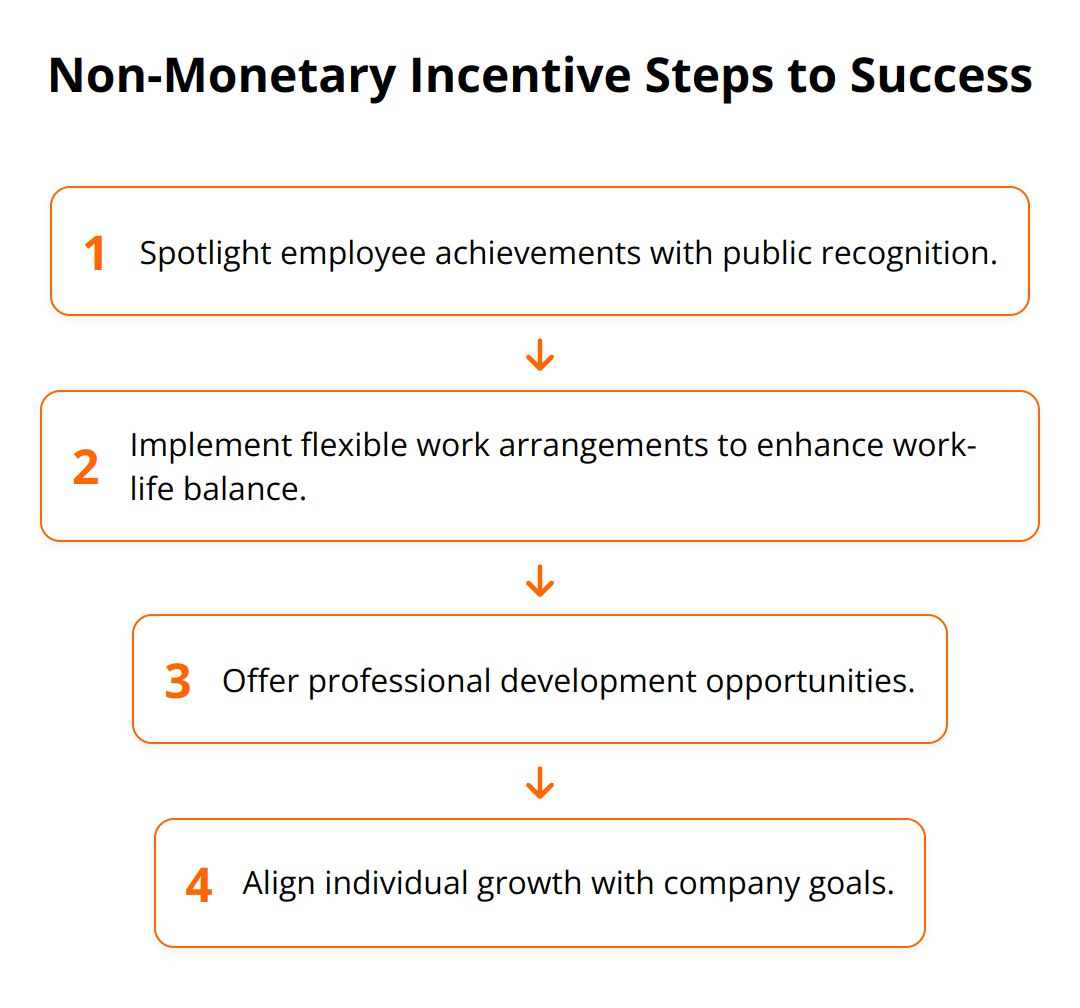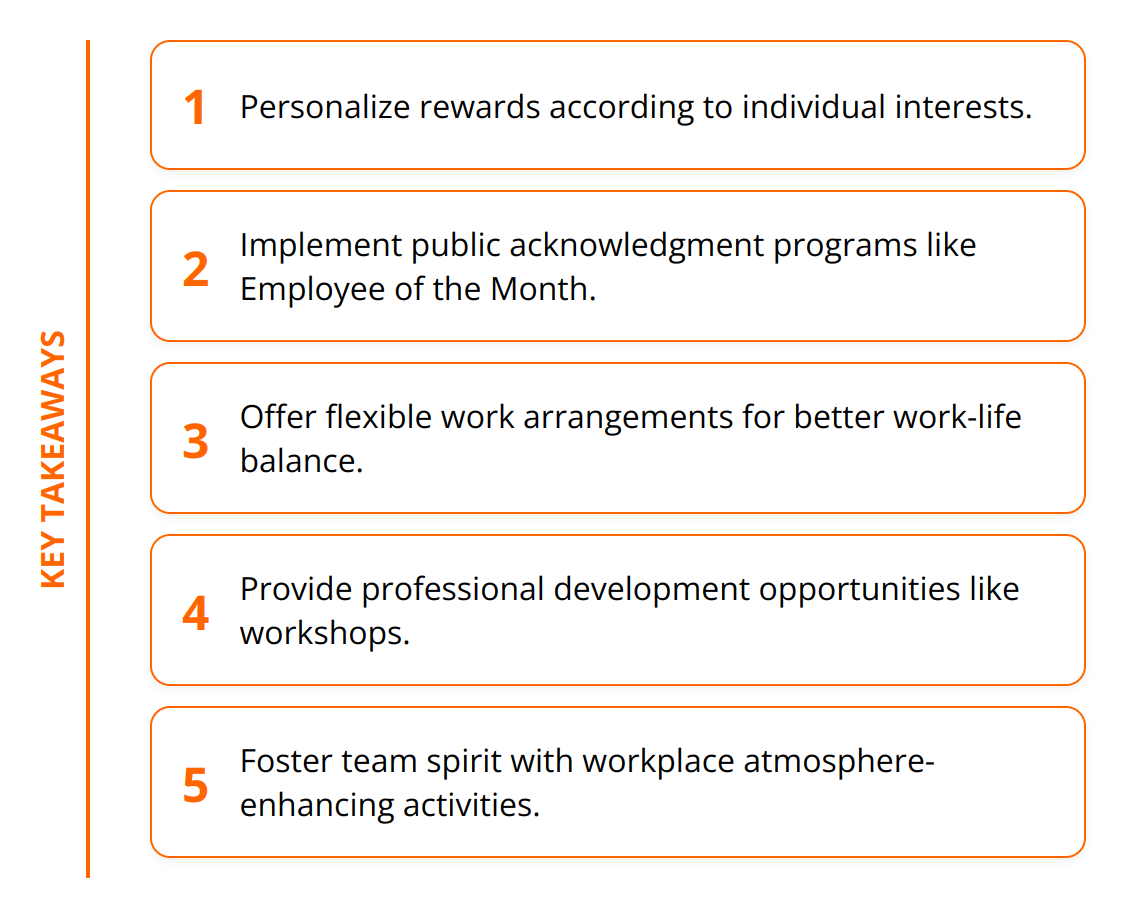
At Reward the World, we understand that a motivated team is the backbone of any successful business. Non-monetary incentives offer a unique way to engage employees without direct financial expenses. These incentives not only boost morale but also foster a positive company culture. This blog: How to Implement Non-Monetary Incentives: Examples, will guide you through understanding, examples, and effective implementation of non-monetary rewards.
Unpacking Non-Monetary Incentives
Non-monetary incentives are a powerful tool for enhancing employee motivation and satisfaction. Unlike monetary rewards, which involve direct financial benefits like bonuses or pay raises, non-monetary incentives focus on offering value that doesn’t have a straightforward cash equivalent. Their importance cannot be overstated, as they tap into intrinsic motivation, promoting job satisfaction and loyalty without adding to the company’s financial burdens.
Core Benefits for Everyone
For employers, the appeal of non-monetary incentives lies in their cost-effectiveness and their long-lasting impact on company culture and employee engagement. They are particularly vital in today’s job market, where attracting and retaining top talent goes beyond just offering a competitive salary. For employees, these incentives resonate on a more personal level, fulfilling their desire for recognition, professional growth, and a balanced work-life.
Significant disparities exist between monetary and non-monetary incentives. While the former might fuel short-term performance boosts, they often induce a competitive atmosphere that might not be healthy in the long term. On the other hand, non-monetary incentives foster a more collaborative and innovative work environment. They encourage employees to think creatively and work together more effectively, as these rewards often recognize teamwork, personal development, and contributions beyond just sales numbers or output metrics.

Practical Implementation Tips
- Personalize Rewards: Tailor incentives to fit individual employee interests and needs. This personal touch significantly enhances the perceived value of the reward.
- Emphasize Recognition: Public acknowledgment in front of peers can be more motivating than a cash bonus for many employees. Consider implementing an Employee of the Month program or acknowledging milestones publicly.
- Offer Professional Development: Opportunities for skills enhancement, like attending workshops or conferences, can be very motivating, promoting both personal and organizational growth.
- Enhance Job Satisfaction: Flexibility in job schedules or work locations can greatly influence an employee’s satisfaction and productivity.
- Foster a Positive Culture: Activities that build team spirit or improve the workplace atmosphere contribute to a more engaged and motivated workforce.

Incorporating non-monetary incentives requires creativity, but the benefits they bring to the table for both employees and employers are undeniable. They not only reduce financial strain on the company but also build a more positive, motivated, and engaged team ready to drive success.
For further inspiration on creating an engaging work environment, consider exploring employee milestone rewards and personalized incentive strategies. These resources provide actionable insights into tailoring rewards programs that resonate deeply with your team’s desires and aspirations.
Implementing Non-Monetary Incentives
Transforming employee motivation within an organization extends beyond monetary compensation. Success stories from leading companies underscore the efficacy of non-monetary incentives in driving employee engagement and fostering a positive workplace culture. Practical examples demonstrate how tailored, thoughtful incentives can significantly impact job satisfaction and productivity.
Showcasing Achievements
Spotlighting employee achievements through public recognition stands out as an immensely powerful motivator. Unlike monetary rewards, the emotional value of being appreciated in front of peers can have a long-lasting positive effect. For instance, creating a “Wall of Fame” or dedicating a section of your internal newsletter to celebrate successes can make employees feel valued and recognized. This not only boosts the morale of the recognized employee but also encourages others to strive for excellence.
Tips for Effective Public Recognition:
- Schedule regular recognition moments in team meetings.
- Use internal communication tools to share achievements widely.
- Encourage peer-to-peer recognition to foster team spirit.

Flexibility as a Reward
Offering flexible work arrangements is another highly effective, cost-efficient incentive. This flexibility can range from remote work options to flexible working hours, accommodating personal commitments and enhancing work-life balance. Studies have shown that such arrangements lead to increased job satisfaction, lower stress levels, and higher productivity. Emphasizing trust and autonomy, flexible work arrangements signal to employees that their well-being and personal life are valued.
Flexibility Best Practices:
- Clearly communicate the options and guidelines for flexible work.
- Implement systems to maintain collaboration and productivity.
- Regularly review flexible arrangements to ensure they meet both employee and company needs.
Growth and Development Opportunities
Professional development opportunities are a cornerstone of an attractive workplace. Employees highly value the chance to grow their skills and advance their careers. Offering access to workshops, courses, training programs, or even sabbaticals for personal projects not only motivates employees but also benefits the organization by enhancing its skill pool. Promoting from within and supporting employees’ career paths contribute significantly to job satisfaction and loyalty.
Strategies for Professional Development:
- Identify individual employees’ growth aspirations and align them with company goals.
- Offer a variety of learning opportunities, from online courses to industry conferences.
- Celebrate educational milestones just as you would project achievements.

Non-monetary incentives like these exemplify how organizations can invest in their teams’ happiness and professional fulfillment without a direct financial cost. By recognizing achievements, offering flexibility, and promoting growth and development, companies can cultivate a motivated, committed, and satisfied workforce poised to drive success. Exploring personalized rewards strategies can further enhance your approach to implementing these non-monetary incentives effectively.
Effective Implementation of Non-Monetary Incentives
Implementing non-monetary incentives successfully hinges on the strategic alignment of company goals with employee needs and aspirations. A transparent and personalized approach ensures that these incentives are not only well-received but also foster a culture of recognition and growth. Here’s how organizations can achieve this balance:
Define Clear Objectives
The first step to an effective incentive program is setting clear objectives. It’s essential to identify what you aim to achieve—be it boosting morale, increasing productivity, improving team collaboration, or promoting innovation. Objectives should align with broader business goals, ensuring that the non-monetary incentives contribute positively to the company’s overall strategy.
Know Your Employees
Understanding the individual preferences and motivations of your team members is crucial. What works for one employee might not work for another. Some may value professional development opportunities more than flexible work arrangements, while others might find recognition in front of their peers especially motivating. Conduct surveys or one-on-one meetings to gather insights into what types of incentives would be most meaningful to each employee.
Transparency and Consistency
Maintain transparency about how decisions regarding incentives are made and ensure that the process is fair and consistent. Clearly communicate the criteria for earning non-monetary rewards and provide regular feedback. This approach not only demystifies the process but also helps in setting expectations, thereby preventing any perceptions of bias or favoritism.
Tailoring Incentives
Craft incentives that align with the personal and professional aspirations of your employees. For example, if an employee shows an interest in advancing their career, providing mentorship programs or access to industry conferences might be particularly effective. On the other hand, employees striving for a better work-life balance might appreciate more flexible working conditions or additional time off.
Open Feedback Channels
Establish open lines of communication for employees to share their feedback about the incentive program. This input is invaluable for refining and improving your approach over time. Act on the feedback where possible, showing employees that their opinions are valued and taken into consideration.
By focusing on personalization, transparency, and alignment with company goals, organizations can create non-monetary incentive programs that not only motivate and engage employees but also drive towards achieving business objectives. Remember, the effectiveness of these programs lies in their ability to resonate personally with employees, reinforcing their importance to the organization beyond their day-to-day tasks.
For practical insights on creating a positive work environment and boosting employee motivation, exploring resources such as employee recognition ideas and professional development opportunities can provide valuable strategies and inspiration.
Wrapping Up
Reflecting on our exploration of non-monetary incentives reveals their undeniable value in today’s workplace. Beyond the mere cost savings, these incentives are a testament to the profound impact recognition, professional growth, and work-life balance have on an employee’s motivation and satisfaction. The emotional and professional rewards garnered from well-thought-out incentives can surpass those of monetary rewards, fostering a culture of appreciation and collaboration that is vital for long-term success.

Customization and communication emerge as critical elements in this realm. Tailoring incentives to match individual goals and maintaining open dialogues about these programs’ structures and outcomes empower employees, making them feel valued on a personal level. This personalization strengthens their connection to the company, thereby boosting morale and productivity.
We encourage businesses to experiment with various forms of non-monetary incentives. Finding the perfect mix that resonates with your team might require trial and error, but the results are well worth the effort. Through experimentation, companies can uncover unique insights into what drives their employees, paving the way for building a more engaged, satisfied, and productive workforce.
As you embark on this journey to enhance your workplace with non-monetary incentives, Reward the World stands ready to support your efforts. With our comprehensive global incentives platform, you can easily integrate a variety of rewards that cater to all demographics, making it simpler to acknowledge your team’s hard work and dedication in meaningful ways. Let us assist you in crafting an environment where employees feel genuinely appreciated and motivated to achieve their best.
In closing, the shift towards non-monetary incentives reflects a deeper understanding of human motivation and the dynamics of the modern workplace. By embracing these strategies, companies of all sizes can cultivate a culture that not only values but also uplifts their employees, steering them towards success and fulfillment.
